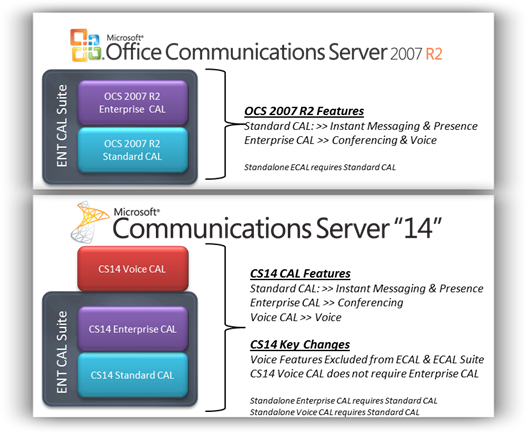Licensing Communications Server “14” Voice and Conferencing
Licensing Communications Server “14” Voice and Conferencing
It has been a busy spring! We provided a first look at Communications Server “14” capabilities at VoiceCon Orlando, published a Microsoft response to the associated IP PBX RFP, and, with other industry leaders, launched the UC Interoperability Forum, or UCIF, a non-profit, open alliance of worldwide technology companies working together to help customers fully realize the potential of unified communications (UC).
Customers confirm the importance of UC interoperability every day when they use our products with their existing gear. In fact, my colleague, Jamie Stark, posted an update on our UC Open Interoperability Program (UCOIP) earlier this week, and gave examples of different customers taking advantage to replace, enhance, or add to their existing IP PBX systems with Communications Server functionality today.
This post provides more information on the licensing changes coming with Communications Server “14” (CS “14) described in the April 15 Microsoft Volume Licensing brief. In a nutshell, with “14” we are offering separate licenses for our enterprise voice functionality and our unified conferencing functionality. This allows customers to choose whether to license our voice, our conferencing, or both. With Office Communications Server (OCS) 2007 R2, a single license covers both conferencing and voice, and customers can only license voice and conferencing together. The difference is shown in the tables below. (The name of the new license is shown in quotes as it is not final.)
The brief also explains that the price of the CS “14” Enterprise CAL will be lower than the price of the OCS 2007 R2 Enterprise CAL, and that customers who purchase the OCS R2 Enterprise CAL before the release of CS “14” and maintain their Software Assurance (SA)will have access rights equivalent to the rights under the “Voice” CAL for the CS “14” release at minimum.

The effect is that existing customers who meet the requirements will get the complete set of enterprise voice functionality we deliver in CS “14” for no additional charge. Some of them will get CS “15” as well.
What about new customers?
A new customer who wants to add Communications Server-based instant messaging, presence, and conferencing to their existing IP PBX system, but who is not yet ready to use our voice capability, will pay less using the CS “14” licensing than they would using the OCS 2007 R2 licensing. The reason is that, as noted above, the CS “14” Enterprise CAL, which is specific to conferencing, costs less than the OCS 2007 R2 Enterprise CAL, which includes both conferencing and voice. The new customer will not pay for voice functionality until they’re ready to use it.
How about a new customer who wants to replace their IP PBX with Communications Server “14”? For example, how would the new structure affect the price for the Microsoft submission to the VoiceCon Orlando IP PBX RFP? To give some background – the VoiceCon show, now Enterprise Connect, issues a mock IP PBX RFP each spring and invites PBX vendors such as Cisco, Avaya, Alcatel, and Siemens to provide a written response, including system level pricing, and participate in a panel discussion at the show. Although we are not a PBX vendor, we participated this year to demonstrate the completeness of our CS “14” voice offer. The pricing in our response is based on the OCS 2007 R2 structure, and is really good. The list price in the Microsoft proposal – including IP phones, gateways, and servers -- is lower than the discounted prices from all other vendors except one. And our discounted price is the lowest. (You can see the pricing summary in a previous blog from me or you can watch a video of the full session by Allan Sulkin.)
If we used the CS “14” licensing for the VoiceCon RFP response, our price would have been even better. The reason is that the new “Voice” CAL will also cost less than the OCS 2007 R2 Enterprise CAL, and includes our full set of telephony features including ad hoc audio conferencing as required by the RFP. As such, a CS “14” bid for a PBX RFP that specifies the CS “14” Standard CAL and “Voice” CAL would be lower than the existing OCS 2007 R2 bid that specifies the OCS 2007 R2 Standard CAL and Enterprise CAL.
A new customer will pay more with CS “14” than OCS 2007 R2 if they want to use our full set of voice and conferencing capabilities to replace or enhance their existing IP PBX systems, but they’ll also get more, including call admission control for voice and video, support for Enhanced 9-1-1, survivable branch telephony, and multiple options for data center resiliency. Our analysis shows that a full Microsoft “14” UC solution including all the functionality covered by the CS “14” Standard, Enterprise, and “Voice” CALs would still be more cost effective than the plain old IP telephony offers from the other vendors that participated in the VoiceCon RFP session.
We offer great value to customers with “14”, and give them the ability to choose how much of our UC stack to use in order to best meet their unique needs.
BJ Haberkorn
OCS Product Management